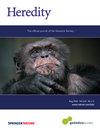三角形:一个R包,用于识别AIMs和建立三角图使用SNP数据从杂交区
IF 3.9
2区 生物学
Q2 ECOLOGY
引用次数: 0
摘要
杂交为物种形成过程提供了一个窗口,并重组亲本等位基因以产生新的重组基因型。杂交区域中特定杂交类别的存在或缺失可以为各种繁殖隔离模式提供支持。通过杂交指数和种间杂合度的组合来区分早期杂种类别,并利用分子数据来估计杂种类别。杂交指数和类间杂合度是杂交区研究的常规计算方法,但下一代测序数据集的可用资源对计算要求很高,而且缺乏可视化三角图的工具。在这里,我们提供了从单核苷酸多态性(SNP)数据集中识别祖先信息标记(AIMs)的资源,计算杂交指数和类间杂合度,并将其关系可视化为三角形图。我们的方法是在R包三角形中实现的。我们在一个经验数据集上验证了我们的方法,并模拟了两个亲本群体之间低、中、高水平分化的杂交区遗传数据。三角模型提供了准确和精确的杂交指数和类间杂合度估计,每个亲本群体的样本量低至5个个体,其误差水平与另一个杂交指数和类间杂合度估计程序bgchm相似。我们探索了用于AIM鉴定的不同等位基因频率差异阈值,以及该阈值如何影响杂交指数和类间杂合度估计的准确性和精度。我们通过描述Hardy-Weinberg均衡下的理论期望,将三角图的解释背景化,并为确定目标和构建三角图提供最佳实践建议。本文章由计算机程序翻译,如有差异,请以英文原文为准。

triangulaR: an R package for identifying AIMs and building triangle plots using SNP data from hybrid zones
Hybridization provides a window into the speciation process and reshuffles parental alleles to produce novel recombinant genotypes. Presence or absence of specific hybrid classes across a hybrid zone can provide support for various modes of reproductive isolation. Early generation hybrid classes can be distinguished by their combination of hybrid index and interclass heterozygosity, which can be estimated with molecular data. Hybrid index and interclass heterozygosity are routinely calculated for studies of hybrid zones, but available resources for next-generation sequencing datasets are computationally demanding and tools for visualizing triangle plots are lacking. Here, we provide a resource for identifying ancestry-informative markers (AIMs) from single nucleotide polymorphism (SNP) datasets, calculating hybrid index and interclass heterozygosity, and visualizing the relationship as a triangle plot. Our methods are implemented in the R package triangulaR. We validate our methods on an empirical dataset and simulations of genetic data from a hybrid zone between two parental groups at low, medium, and high levels of divergence. triangulaR provides accurate and precise estimates of hybrid index and interclass heterozygosity with sample sizes as low as five individuals per parental group, and similar levels of error as another program for hybrid index and interclass heterozygosity estimation, bgchm. We explore various allele frequency difference thresholds for AIM identification, and how this threshold influences the accuracy and precision of hybrid index and interclass heterozygosity estimates. We contextualize interpretation of triangle plots by describing theoretical expectations under Hardy-Weinberg Equilibrium and provide recommendations for best practices for identifying AIMs and building triangle plots.
求助全文
通过发布文献求助,成功后即可免费获取论文全文。
去求助
来源期刊

Heredity
生物-进化生物学
CiteScore
7.50
自引率
2.60%
发文量
84
审稿时长
4-8 weeks
期刊介绍:
Heredity is the official journal of the Genetics Society. It covers a broad range of topics within the field of genetics and therefore papers must address conceptual or applied issues of interest to the journal''s wide readership
 求助内容:
求助内容: 应助结果提醒方式:
应助结果提醒方式:


